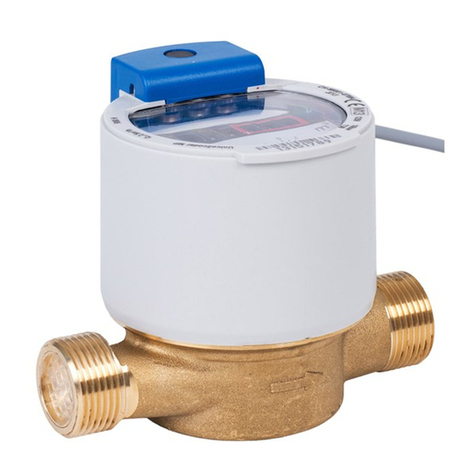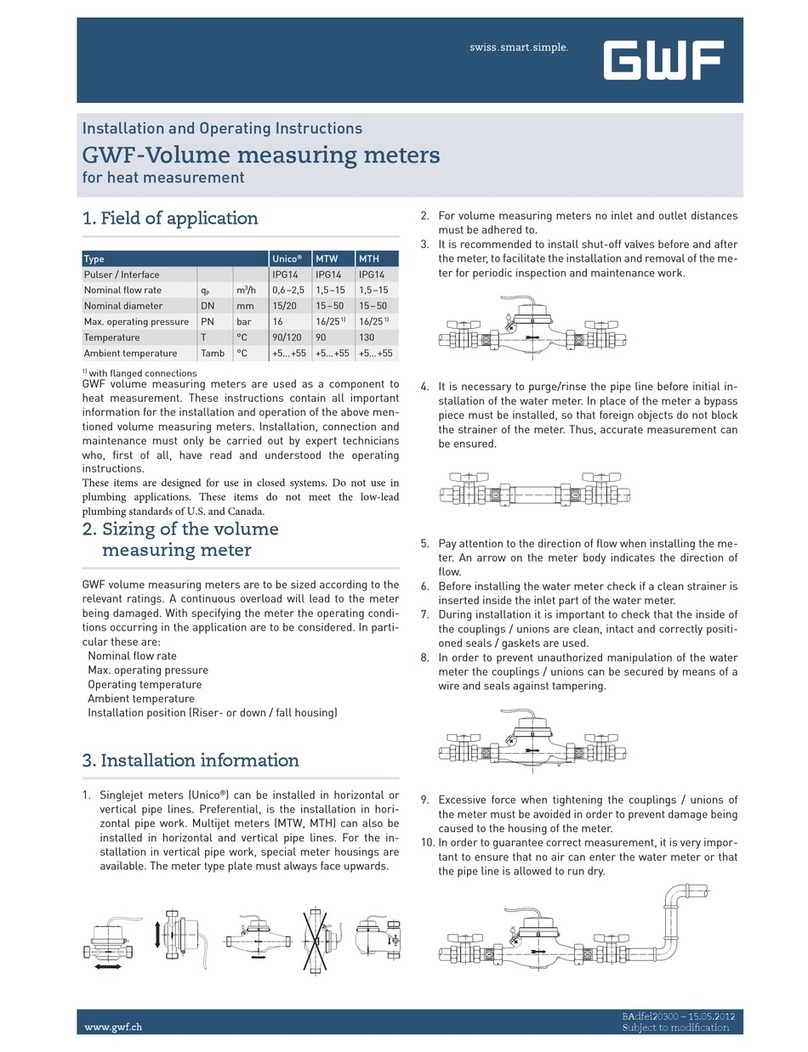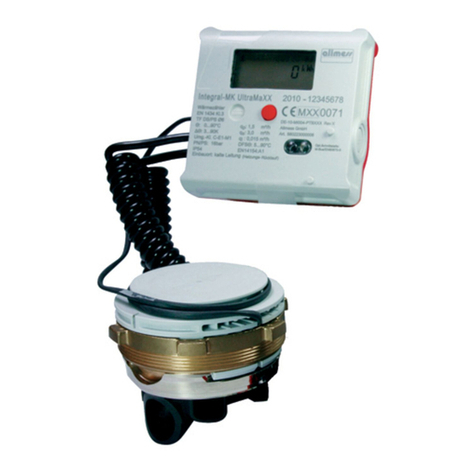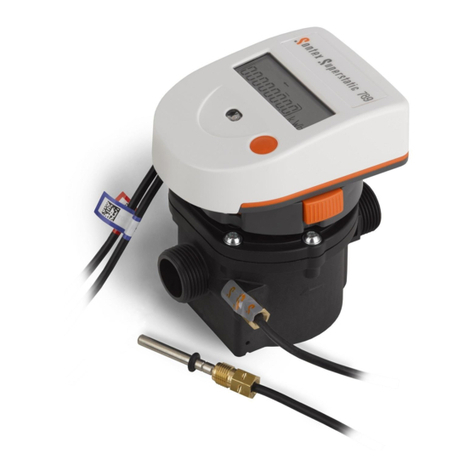
BAdfei20300 - 14.02.2023 - Änderungen vorbehalten - Modications réservés - Subject to modication - Con riserva di modiche
GWF AG
Obergrundstrasse 119
6005 Luzern, Schweiz
T +41 41 319 50 50
GWF AG
Bureau de la Suisse romande:
Z.I. de la Vulpillière 61b
1070 Puidoux, Suisse
T +41 21 633 21 40
www.gwf.ch
Montage- und Betriebsanleitung
GWF-Volumenmessteile
für Wärmezähler
1. Bestimmungsgemässe Verwendung
GWF-Volumenmessteile sind geeignet zur Durchflussmessung als Bestand-
teil eines Wärmezählers. Diese Anleitung enthält alle wichtigen Informatio-
nen für den Einbau und den Betrieb der oben aufgeführten Volumenmessteile.
Einbau, Anschluss und Wartung sind durch sach- und fachkundiges Personal
durchzuführen, welches zuvor diese Montage- und Betriebsanleitung gelesen
und verstanden hat.
2. Auslegung der Volumenmessteile
GWF-Volumenmessteile sind den Belastungswerten entsprechend auszule-
gen. Eine dauerhafte Überlastung führt zu deren Beschädigung. Bei der tech-
nischen Spezifikation sind die in der Anlage vorkommenden Betriebsbedin-
gungen zu berücksichtigen. Dies sind insbesondere:
■Nenndurchfluss ■Umgebungstemperatur
■Max. zulässiger Betriebsdruck ■Einbaulage (Steig-
■Betriebstemperatur oder Fallrohrgehäuse)
3. Einbauhinweise
1. Einstrahlzähler (Unico®) können sowohl in horizontale wie auch in verti-
kale Leitungen eingebaut werden. Bevorzugt ist der Einbau in horizontal
verlaufenden Leitungen (Abb. 3.1).
Mehrstrahlzähler (MTW, MTH) können ebenfalls in horizontale wie verti-
kale Leitungen eingebaut werden. Für den Einbau in vertikale Leitungen
stehen spezielle Umlenkgehäuse zur Verfügung. Das Ziffernblatt ist im-
mer nach oben zu richten (Abb. 3.1).
2. Für das Volumenmessteil ist keine Ein- und Auslaufstrecke notwendig.
3. Es wird empfohlen, vor und nach dem Volumenmessteil ein Absperrorgan
in die Leitung einzubauen, um dessen Ein und Ausbau bei periodischen
Kontrollen und Wartungsarbeiten zu erleichtern (Abb. 3.3).
4. Vor dem Ersteinbau des Volumenmessteils soll das Rohrleitungsnetz ge-
spült werden. Anstelle des Volumenmessteils soll ein Passstück eingebaut
werden, so dass evtl. Festpartikel nicht unnötig das Schmutzsieb verstop-
fen. Dadurch wird ein einwandfreies Messen gewährleistet (Abb. 3.4).
5. Beim Einbau des Volumenmessteils ist auf die Durchflussrichtung zu ach-
ten. Ein auf dem Gehäuse angebrachter Pfeil zeigt die Durchflussrichtung
an.
6. Vor dem Einbau des Volumenmessteils ist sicherzustellen, dass auf der
Eingangsseite ein sauberes Schmutzsieb eingebaut ist.
7. Beim Einbau ist weiter darauf zu achten, dass in den Verschraubungen
saubere, unbeschädigte und richtig positionierte Dichtungen verwendet
werden.
8. Um ein unbefugtes Manipulieren am Volumenmessteil zu verhindern, kön-
nen die Verschraubungen mittels Draht und Plomben gegen ein Öffnen
gesichert werden (Abb. 3.8).
9. Das Volumenmessteil darf keinen von Rohren oder Formstücken verur-
sachten Spannungen ausgesetzt werden, d.h. das Einbaulichtmass muss
eingehalten werden.
10. Um ein korrektes Messen sicherzustellen, ist darauf zu achten, dass we-
der Luft in das Volumenmessteil gelangen noch die Leitung vom Volumen-
messteil leer laufen kann (Abb. 3.10).
11. Bei vielen Installationen dienen Wasserleitungen als Masse für elektri-
sche Anlagen. Entsprechend der vorliegenden Situation ist eine elektri-
sche Überbrückung des Volumenmessteils zu gewährleisten.
12. Das Volumenmessteil ist gegen eine Beschädigung durch mechanische
Schläge oder Vibrationen, welche am Einbauort entstehen können, zu
schützen.
13. Die Rohrleitungen des Heizsystems sind vor und hinter dem Volumen-
messteil ausreichend zu verankern.
14. Es sind Massnahmen zu treffen, damit das Volumenmessteil durch hyd-
raulische Einflüsse wie Kavitation, Rückschläge oder Druckstösse nicht
beschädigt wird. Ebenfalls ist sicherzustellen, dass das Volumenmessteil
nicht durch gefrorenes Wasser zerstört wird.
15. Signalleitungen dürfen nicht unmittelbar neben Hauptversorgungsleitun-
gen verlegt werden und müssen unabhängig voneinander geschützt sein.
Der Abstand zwischen Signal- und Versorgungsleitung muss mind. 50mm
betragen.
16. Signalleitungen zwischen Teilen eines Wärmezählers sind so zu verlegen,
dass sie vor Störungen und unbefugten Unterbrechungen gesichert sind.
4. Inbetriebnahme
Bei der Inbetriebnahme und nach jeder Entleerung sind die Absperrorgane
langsam zu öffnen, um Druckschläge auf das Volumenmessteil zu vermeiden.
5. Überwachung und Wartung
In der Regel benötigen GWF-Volumenmessteile keine Wartung. Sie zeichnen
sich zudem durch eine lange Lebensdauer aus. Die Einsatzdauer hängt im
Wesentlichen von der Wasserqualität und von der Grösse des Durchflusses
ab. Wir empfehlen jedoch, folgende Punkte periodisch zu überprüfen.
1. Vor dem Arbeiten an der Anlage ist zu prüfen, ob der Druck in der Leitung
entlastet ist.
2. Es ist zu prüfen, ob bei geschlossener Zuleitung alle Zeiger im Zählwerk
still stehen und beim langsamen Öffnen der Zuleitung sich die Zeiger
ebenfalls langsam und gleichmässig zu drehen beginnen.
3. Falls das Leitungsnetz stark verschmutzt sein sollte, wird empfohlen, das
Schmutzsieb auf der Eingangsseite zu reinigen.
4. Es ist zu prüfen, ob die Stempelzeichen intakt und unbeschädigt sind.
5. Es ist zu prüfen, ob die Absperrorgane vor und hinter dem Volumenmess-
teil völlig offen sind, ob sie geschlossen werden können und ob sie nicht
undicht sind.
6. Es ist zu prüfen, ob das Volumenmessteil und die Zuleitungen des Heiz-
systems dicht sind.
7. Es ist zu prüfen, ob in der Umgebung des Volumenmessteils kein Wasser
vorhanden ist, welches auf das Zählwerk tropft und so in dieses eindringen
kann.
8. Es ist zu prüfen, ob alle Wärmezählerzuleitungen sicher angeschlossen
sind und ob die Leitungen unbeschädigt sind.
9. Es ist zu prüfen, ob die Umgebungstemperatur innerhalb des für den Wär-
mezähler festgelegten Temperaturbereichs liegt.
Grundlage für den Einbau, die Inbetriebnahme, die Überwachung und die
Wartung ist die EN 1434, Teil 6 – Wärmezähler.
6. Demontage und Recycling
Es ist darauf zu achten, dass die Volumenmessteile recyclinggerecht entsorgt
werden.
7. Einsatz von Frostschutzmitteln
GWF-Volumenmessteile sind beständig im Einsatz von Frostschutzmitteln auf
Basis von Ethylenglykol und Propylenglykol. Die Messdynamik wird hingegen
je nach Konzentration wie folgt eingeschränkt:
Typ Unico®MTW MTH
Schnittstelle IPG14 IPG14 IPG14
Nenndurchfluss qpm3/h 0,6–2,5 1,5–15 1,5–15
Nennweite DN mm 15/20 15–50 15–50
Nenndruck PN bar 16 16/251) 16/251)
Temperatur T°C 90/120 90 130
Umgebungstemperatur Tamb °C +5…+55 +5…+55 +5…+55
1) mit Flansch
1. Bis 5% Frostschutzanteil ergibt sich keine Änderung der Messdynamik
2. Bis 30% Frostschutzanteil muss mit einer Verdoppelung des qi-Wertes ge-
rechnet werden. Die Verschlechterung verhält sich proportional.
3. Bei Frostschutzanteilen von ›30% wird von einem Einsatz unserer Flügel-
radzähler abgeraten.
8. Sicherheitshinweise
1. Das Volumenmessteil ist immer am Gehäuse und nicht am Deckel oder
dem «Kommunikationskabel» zu halten bzw. zu tragen.
2. Die Geräte dürfen nur zum bestimmungsgemässen Verwendungszweck
eingesetzt werden. GWF AG garantiert im Rahmen der allgemeinen Ge-
schäftsbedingungen für die Qualität des Produktes. Die Haftung für die
richtige Installation sowie fachgemässe Handhabung geht mit dem Emp-
fang der Ware auf den Eigentümer oder Betreiber über.
9. Technische Daten IPG14
Schaltelement Reed
Schaltspannung Umax 42V AC/DC
Schaltstrom Imax 100mA
Schaltleistung Pmax 4W
Schutzwiderstand R18 Ohm
Leiterquerschnitt 0,14mm2
Schaltzyklen ca. 107
Instructions de montage et de service
Parties hydrauliques (débitmètre) GWF
pour les compteurs de chaleur
Type Unico®MTW MTH
Interface IPG14 IPG14 IPG14
Débit nominal qpm3/h 0,6–2,5 1,5–15 1,5–15
Diamètre nominal DN mm 15/20 15–50 15–50
Pression nominale PN bar 16 16/251) 16/251)
Température T°C 90/120 90 130
Température ambiante Tamb °C +5…+55 +5…+55 +5…+55
1) avec brides
1. Utilisation selon prescription
3. Il est recommandé de monter une vanne d’arrêt dans la conduite avant et
après la partie hydraulique, pour faciliter le montage et démontage lors de
contrôles périodiques et travaux d’entretien (fig. 3.3).
4. Il faut purger le réseau des conduites avant de monter la première fois la
partie hydraulique. Un gabarit doit être monté à la place de la partie hyd-
raulique, afin que d’éventuelles particules dures ne bloquent inutilement
le filtre. Une mesure exacte est ainsi garantie (fig. 3.4).
5. Il faut respecter le sens du débit lors du montage de la partie hydraulique.
Une flèche sur le corps indique le sens du débit.
6. Il faut s’assurer avant le montage, qu’un filtre propre ait été monté à
l’entrée.
7. Veiller également lors du montage à placer des joints propres, intacts et
positionnés correctement dans les raccords.
8. Afin d’éviter une manipulation non autorisée sur de la partie hydraulique,
les raccords peuvent être protégés contre une ouverture par des fils et
plombs (fig. 3.8).
9. La partie hydraulique ne doit subir aucune tension provenant des tuyaux
ou pièces de forme, le diamètre de montage doit être respecté.
10. Pour s’assurer d’une mesure correcte, il faut veiller à ce que de l’air ne
pénètre pas dans la partie hydraulique et que la conduite de la partie hyd-
raulique ne fonctionne pas à vide (fig. 3.10).
11. Dans beaucoup d’installations, les conduites d’eau servent de masse pour
les installations électriques. Dans chaque situation, il faut garantir un
pontage électrique de la partie hydraulique.
12. Il faut protéger la partie hydraulique contre une détérioration provenant de
coups mécaniques ou vibrations pouvant se produire sur le lieu de montage.
13. Il faut ancrer suffisamment les conduites du système de chauffage avant
et après la partie hydraulique.
14. Il faut prendre des mesures, pour que la partie hydraulique ne soit pas dé-
tériorée par des influences hydrauliques comme la cavitation, nonretour
ou coup de bélier. Il faut aussi s’assurer que la partie hydraulique ne soit
pas brisé par de l’eau gelée.
15. Les lignes de signalisation ne doivent pas être posées directement à côté
des lignes d’alimentation principale et doivent être protégées séparément.
La distance entre la ligne de signalisation et celle d’alimentation doit être
au moins de 50mm.
16. Les lignes de signalisation entre les pièces d’un compteur de chaleur
doivent être posées de telle façon à ce qu’elles soient protégées contre des
perturbations et coupures non autorisées.
4. Mise en service
Lors de la mise en service et après chaque vidange, il faut ouvrir lentement
les vannes d’arrêt pour éviter des coups de bélier sur la partie hydraulique.
5. Contrôle et entretien
En règle générale, les parties hydrauliques GWF n’ont pas besoin d’entretien.
Ils se caractérisent par une longue durée de vie. Leur durée d’utilisation dé-
pend essentiellement de la qualité de l’eau et de la grandeur du débit. Nous
recommandons cependant de contrôler périodiquement les points suivants:
1. Avant de travailler sur l’installation, il faut vérifier si la conduite est dé-
pressurisée.
2. Il faut vérifier, si toutes les aiguilles du totalisateur sont immobiles lorsque
la conduite est fermée, et qu’en ouvrant lentement cette conduite les ai-
guilles commencent à tourner lentement et régulièrement.
3. Si la conduite est encrassée, il est recommandé de nettoyer le filtre à
l’entrée.
4. Il faut vérifier que les poinçons soient intacts et non détériorés.
5. Vérifier si les vannes d’arrêt avant et après la partie hydraulique sont ou-
vertes complètement, si elles peuvent être fermées et si elles sont bien
étanches.
6. Vérifier si la partie hydraulique et les conduites d’arrivée du système de
chauffage n’ont pas de fuites.
7. Vérifier s’il n’y a pas de l’eau à proximité, qui pourrait couler sur la partie
hydraulique et pénétrer.
8. Vérifier si toutes conduites d’amenée au compteur de chaleur sont bien
branchées et si elles sont en bon état.
9. Vérifier si la température ambiante est située dans la plage de tempéra-
ture définie pour le compteur de chaleur.
La base pour le montage, la mise en service, le contrôle et l’entretien est la
EN 1434, partie 6 – compteur de chaleur.
6. Démontage et recyclage
Il faut veiller à ce que les parties hydrauliques soient collectés de façon à
permettre un recyclage.
7. Utilisation de produits antigel
Les parties hydrauliques GWF sont résistants à l’utilisation de produits antigel
à base d’éthylèneglycol et propylèneglycol. La dynamique de mesure est ce-
pendant réduite selon la concentration:
1. Jusqu’à 5% d’antigel pas de modification de la dynamique de mesure
2. Jusqu’à 30% d’antigel il faut compter un doublement de la valeur qi. Une
dégradation de la sensibilité est ensuite proportionelle.
3. Si la concentration de l’antigel est supérieure à 30%, il est déconseillé
d’utiliser nos compteurs vitesse.
8. Consignes de sécurité
1. Il faut toujours saisir la partie hydraulique par le corps et non par le cou-
vercle ou le «module de communication».
2. N’utiliser les appareils de mesure que pour l’usage prévu.GWF AG garantit
la qualité du produit dans les limites des conditions générales. La respon-
sabilité du fait de l’installation et du maniement passe au propriétaire ou à
l’exploitant au moment de la réception de la marchandise.
9. Données techniques IPG14
Elément de commutation Reed
Tension de commutation Umax 42V AC/DC
Courant de commutation Imax 100mA
Puissance de commutation Pmax 4W
Résistance protectrice R18 Ohm
Coupe du conducteur 0,14mm2
Cycles de commutation env. 107
Les parties hydrauliques GWF sont appropriées à la mesure du débit en tant
que composante du compteur de chaleur. Cette introduction comprend tou-
tes les informations importantes pour le montage et le fonctionnement des
parties hydrauliques mentionnés ci-dessus. Le montage, le raccordement et
l’entretien doivent être exécutés par du personnel qualifié, qui aura auparvant
lu et compris cette instruction de montage et de service.
2. Dimensionnement des parties hydrauliques
Les parties hydrauliques doivent être dimensionnés en fonction des débits
nominaux. Une surcharge permanente pourrait provoquer leur détérioration.
Lors de la spécification technique, il faut tenir compte des conditions de fon-
ctionnement; en particulier:
■Débit nominal
■Pression max. admissible de service
■Température de service
■Température ambiante
■Montage (corps vertical entrée dessous ou corps vertical entrée dessus)
3. Conseils de montage
1. Des compteurs d’eau à jet unique (Unico®) peuvent être montés horizon-
talement ou verticalement. Il est cependant préférable de les monter ho-
rizontalement (fig. 3.1). Les compteurs d’eau à jets multiples (MTW, MTH)
peuvent également être montés horizontalement ou verticalement. Des
corps de renvoi spéciaux sont à disposition pour un montage vertical dans
une conduite. Il faut toujours diriger le cadran vers le haut (fig. 3.1).
2. Un tronçon d’entrée et de sortie ne sont pas nécessaires pour la partie
hydraulique.
Abb/fig. 3.1
Abb/fig. 3.3
Abb/fig. 3.4
Abb/fig. 3.8
Abb/fig. 3.10
UE Déclaration de conformité
Fabricant GWF AG, Obergrundstrasse 119, 6005 Luzern, Suisse
Produit Partie hydraulique pour compteur de chaleur
Type, modèle MTW3… MTH3… Unico2…
Marquage produit Mxx 1259
CH-MI004-07004, CH-MI004-07003
Directives EU 2014/32/EU─MID
www.metas.ch/certsearch
Normes EN 1434-1:2015
Examen CE de type CH-MI004-07004/CH-MI004-07003,
MID–2014/32/EUAnnexeII,moduleB
EidgenössischesInstitutfürMetrologie,METAS-Cert
CH-3003Bern-Wabern,NotiedBody1259
Procédé de surveillance MID–2014/32/EUAnnexeII,moduleD
EidgenössischesInstitutfürMetrologie,METAS-Cert
CH-3003Bern-Wabern,NotiedBody1259
Déclaration du fabricant:
Lesproduitsdésignésenconséquenceontétéfabriquésconformémentauxexigencesdes
DirectivesetNormescitées.Ilssontconformesautypeéprouvé.Lafabricationestsoumiseau
Procédédesurveillanceindiqué.
01.02.2023
MarkusHelfenstein ThomasBirer
SeniorVPR&D HeadofMetrologyLaboratory
EU Konformitätserklärung
Hersteller GWF AG, Obergrundstrasse 119, 6005 Luzern, Schweiz
Produkt Volumenmessteil zu Wärmezähler
Typ, Ausführung MTW3… MTH3… Unico2…
Produkt Kennzeichnung Mxx 1259
CH-MI004-07004, CH-MI004-07003
EU-Richtlinie 2014/32/EU─MID
www.metas.ch/certsearch
Normen EN 1434-1:2015
Bauartprüfzertikat CH-MI004-07004/CH-MI004-07003,
MID-2014/32/EUAnhangII,ModulB
EidgenössischesInstitutfürMetrologie,METAS-Cert
CH-3003Bern-Wabern,NotizierteStelle/NotiedBody1259
Überwachungsvertahren 2014/32/EUAnhangII,ModulD
EidgenössischesInstitutfürMetrologie,METAS-Cert
CH-3003Bern-Wabern,NotizierteStelle/NotiedBody1259
Wir erklären als Hersteller:
DieentsprechendgekennzeichnetenProduktesindnachdenaufgeführtenRichtlinienund
Normenhergestellt.SiestimmenmitdemgeprüftenBaumusterüberein.DieHerstellung
unterliegtdemgenanntenÜberwachungsverfahren.
01.02.2023
MarkusHelfenstein ThomasBirer
SeniorVPR&D HeadofMetrologyLaboratory

























